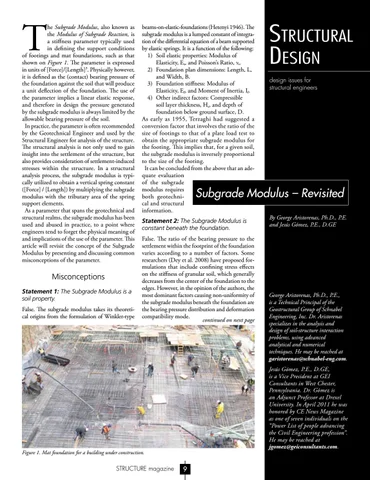T
he Subgrade Modulus, also known as the Modulus of Subgrade Reaction, is a stiffness parameter typically used in defining the support conditions of footings and mat foundations, such as that shown on Figure 1. The parameter is expressed in units of [Force]/[Length]3. Physically however, it is defined as the (contact) bearing pressure of the foundation against the soil that will produce a unit deflection of the foundation. The use of the parameter implies a linear elastic response, and therefore in design the pressure generated by the subgrade modulus is always limited by the allowable bearing pressure of the soil. In practice, the parameter is often recommended by the Geotechnical Engineer and used by the Structural Engineer for analysis of the structure. The structural analysis is not only used to gain insight into the settlement of the structure, but also provides consideration of settlement-induced stresses within the structure. In a structural analysis process, the subgrade modulus is typically utilized to obtain a vertical spring constant ([Force] / [Length]) by multiplying the subgrade modulus with the tributary area of the spring support elements. As a parameter that spans the geotechnical and structural realms, the subgrade modulus has been used and abused in practice, to a point where engineers tend to forget the physical meaning of and implications of the use of the parameter. This article will revisit the concept of the Subgrade Modulus by presenting and discussing common misconceptions of the parameter.
Misconceptions Statement 1: The Subgrade Modulus is a soil property. False. The subgrade modulus takes its theoretical origins from the formulation of Winkler-type
beams-on-elastic-foundations (Hetenyi 1946). The subgrade modulus is a lumped constant of integration of the differential equation of a beam supported by elastic springs. It is a function of the following: 1) Soil elastic properties: Modulus of Elasticity, Es, and Poisson’s Ratio, νs. 2) Foundation plan dimensions: Length, L, and Width, B. 3) Foundation stiffness: Modulus of Elasticity, Ef, and Moment of Inertia, If. 4) Other indirect factors: Compressible soil layer thickness, Hs, and depth of foundation below ground surface, D. As early as 1955, Terzaghi had suggested a conversion factor that involves the ratio of the size of footings to that of a plate load test to obtain the appropriate subgrade modulus for the footing. This implies that, for a given soil, the subgrade modulus is inversely proportional to the size of the footing. It can be concluded from the above that an adequate evaluation of the subgrade modulus requires both geotechnical and structural information.
Structural DeSign design issues for structural engineers
Subgrade Modulus – Revisited
Statement 2: The Subgrade Modulus is constant beneath the foundation. False. The ratio of the bearing pressure to the settlement within the footprint of the foundation varies according to a number of factors. Some researchers (Dey et al. 2008) have proposed formulations that include confining stress effects on the stiffness of granular soil, which generally decreases from the center of the foundation to the edges. However, in the opinion of the authors, the most dominant factors causing non-uniformity of the subgrade modulus beneath the foundation are the bearing pressure distribution and deformation compatibility mode. continued on next page
George Aristorenas, Ph.D., P.E., is a Technical Principal of the Geostructural Group of Schnabel Engineering, Inc. Dr. Aristorenas specializes in the analysis and design of soil-structure interaction problems, using advanced analytical and numerical techniques. He may be reached at garistorenas@schnabel-eng.com. Jesús Gómez, P.E., D.GE, is a Vice President at GEI Consultants in West Chester, Pennsylvania. Dr. Gómez is an Adjunct Professor at Drexel University. In April 2011 he was honored by CE News Magazine as one of seven individuals on the “Power List of people advancing the Civil Engineering profession”. He may be reached at jgomez@geiconsultants.com.
Figure 1. Mat foundation for a building under construction.
STRUCTURE magazine
By George Aristorenas, Ph.D., P.E. and Jesús Gómez, P.E., D.GE
9





